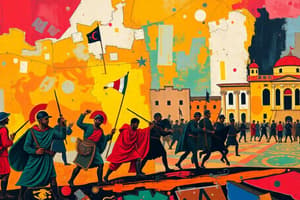Podcast
Questions and Answers
What type of problems are complex, nonlinear and dynamic?
What type of problems are complex, nonlinear and dynamic?
Ill-Structured problems.
Fear of failure, binding customs and command pressure are a few examples of what?
Fear of failure, binding customs and command pressure are a few examples of what?
Road blocks to problem solving.
What do leaders use to analyze possible solutions?
What do leaders use to analyze possible solutions?
Leaders use screening criteria and benchmarks to analyze possible solutions.
What is the seven-step process in military problem solving?
What is the seven-step process in military problem solving?
Define a problem in terms of military problem solving.
Define a problem in terms of military problem solving.
Problems that are easy to identify, required information is available, and methods to solve them are somewhat obvious are known as?
Problems that are easy to identify, required information is available, and methods to solve them are somewhat obvious are known as?
Problems that are more interactively complex than well-structured problems are known as?
Problems that are more interactively complex than well-structured problems are known as?
What are the most challenging structured problems to solve?
What are the most challenging structured problems to solve?
The key to understanding situations, finding causes, making good judgments, and learning from experience is known as?
The key to understanding situations, finding causes, making good judgments, and learning from experience is known as?
What comes into play when leaders apply imagination?
What comes into play when leaders apply imagination?
How many steps are in the problem solving process, and what are they?
How many steps are in the problem solving process, and what are they?
An assumption is known as what?
An assumption is known as what?
What constitutes a problem existing?
What constitutes a problem existing?
During the step of developing criteria, what are some screening measures?
During the step of developing criteria, what are some screening measures?
During the step of developing criteria, what are some evaluating measures?
During the step of developing criteria, what are some evaluating measures?
When generating possible solutions during the Military Problem Solving Process, how do leaders accurately record each possible solution?
When generating possible solutions during the Military Problem Solving Process, how do leaders accurately record each possible solution?
When leaders analyze each solution to determine its merits and drawbacks, what have they done first?
When leaders analyze each solution to determine its merits and drawbacks, what have they done first?
What continues throughout the Problem Solving Process?
What continues throughout the Problem Solving Process?
Leaders cannot understand or identify the problem without first doing what?
Leaders cannot understand or identify the problem without first doing what?
During the Problem Solving Process, what components of the first three steps are linked?
During the Problem Solving Process, what components of the first three steps are linked?
Flashcards are hidden until you start studying
Study Notes
Military Problem Solving Overview
- Problems can be categorized as well-structured, medium-structured, or ill-structured depending on their complexity.
- Ill-structured problems are complex, nonlinear, and dynamic, making them challenging to solve.
- Well-structured problems are easy to identify, have readily available information, and have obvious solutions.
Problem Definition and Existence
- A problem in military context refers to an issue that obstructs achieving a desired goal or end state.
- A problem exists when there is a discrepancy between the current state and the desired state.
Problem Solving Process
- The military problem-solving process consists of seven key steps:
- Identify the problem
- Gather information and knowledge
- Develop criteria
- Generate possible solutions
- Analyze possible solutions
- Compare possible solutions
- Make and implement the decision
Criteria Development
- Developing criteria involves both screening measures (e.g., suitability, feasibility, acceptance) and evaluating measures (e.g., short title, definition, unit of measure, benchmarks).
Solution Analysis
- Leaders use screening criteria and benchmarks to analyze potential solutions and assess their merits and drawbacks.
- Accurate recording of possible solutions is done through summarizing in writing and sketches.
Role of Information and Reasoning
- Continuous gathering of information and knowledge is vital throughout the problem-solving process.
- Critical reasoning is essential for understanding situations, analyzing causes, and making informed judgments.
Creative and Critical Thinking
- Creative thinking is employed when leaders use imagination to explore different solutions.
- Assumptions play a role in planning as they provide necessary context for evaluating the current situation and projecting future outcomes.
Connection of Components
- The first three steps of the problem-solving process are interconnected through facts, assumptions, interests, and fundamental questions (who, what, when, where, and why).
- Screening and evaluation are crucial components that help guide the analysis and decision-making process.
Studying That Suits You
Use AI to generate personalized quizzes and flashcards to suit your learning preferences.




